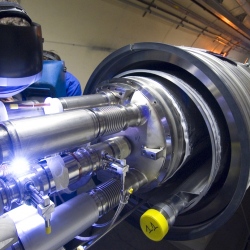
It feels like the Large Hadron Collider has just barely started doing science (and it’s not even at full strength yet), but already plans are underway for its successor: the International Linear Collider, or ILC. The ILC will likely cost between $10 and $20 billion, and it’s now looking like the host country will probably be Japan.
The LHC has done a stupendous job of colliding hadrons with each other. Hadrons, of course, are particles made up of other particles: a proton, for example, is made of three quarks (two up quarks and a down quark) held together with gluons. The LHC’s circular design makes it possible to accelerate hadrons up to enormous energies and collide them efficiently.
The problem with using a circular collider is that you can’t effectively use it for light particles like electrons. The reason for this is slightly complicated, but basically, whenever a charged particle is moving very fast in a circle, it gives off something called synchrotron radiation, which sucks away some of the energy that you’re using to try to accelerate it. The amount of energy loss decreases by a huge amount as the mass of the particle increases, so with heavier particles (like protons and the lead nuclei that the LHC collides), it’s not so much of an issue. With something like an electron, which is 1,836 times less massive than a proton, synchrotron radiation starts to become a real problem.
To accelerate lightweight charged particles like electrons and anti-electrons, then, you have to work in straight lines, which means using a linear accelerator instead of a circular one. Unfortunately, the way straight lines work means that your particles just run through your accelerator once instead of a bunch of times, reducing the amount of energy that you can pack into them. In short, a linear accelerator can’t get up to nearly the same amount of collision energy that a circular accelerator can: when upgraded in 2014, the LHC will reach collision energies of 14,000 GeV, while the ILC will top out at just 500 GeV, even with an accelerator track that’s 31 kilometers long.
